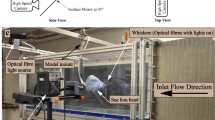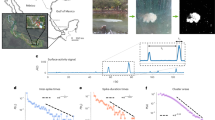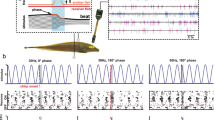Abstract
Stochastic resonance is the phenomenon whereby the addition of an optimal level of noise to a weak information-carrying input to certain nonlinear systems can enhance the information content at their outputs1,2,3,4. Computer analysis of spike trains has been needed to reveal stochastic resonance in the responses of sensory receptors5,6,7 except for one study on human psychophysics8. But is an animal aware of, and can it make use of, the enhanced sensory information from stochastic resonance? Here, we show that stochastic resonance enhances the normal feeding behaviour of paddlefish (Polyodon spathula)9,10, which use passive electroreceptors11,12 to detect electrical signals from planktonic prey13. We demonstrate significant broadening of the spatial range for the detection of plankton when a noisy electric field of optimal amplitude is applied in the water. We also show that swarms of Daphnia plankton are a natural source of electrical noise. Our demonstration of stochastic resonance at the level of a vital animal behaviour, feeding, which has probably evolved for functional success, provides evidence that stochastic resonance in sensory nervous systems is an evolutionary adaptation14.
This is a preview of subscription content, access via your institution
Access options
Subscribe to this journal
Receive 51 print issues and online access
$199.00 per year
only $3.90 per issue
Buy this article
- Purchase on Springer Link
- Instant access to full article PDF
Prices may be subject to local taxes which are calculated during checkout





Similar content being viewed by others
References
Wiesenfeld,K. & Moss,F. Stochastic resonance and the benefits of noise: from ice ages to crayfish and SQUIDS. Nature 373, 33–36 (1995).
Gammaitoni,L., Hanggi,P., Jung,P. & Marchesoni,F. Stochastic resonance. Rev. Mod. Phys. 70, 223–288 (1998).
Bulsara,A. & Gammaitoni,L. Tuning in to noise. Phys. Today 49, 39–45 (1996).
Bezrukov,S. M. & Vodyanoy,I. Stochastic resonance in non-dynamical systems without response thresholds. Nature 385, 319–321 (1997).
Douglass,J. K., Wilkens,L., Pantazelou,E. & Moss,F. Noise enhancement of information transfer in crayfish mechanoreceptors by stochastic resonance. Nature 365, 337–340 (1993).
Levin,J. E. & Miller,J. P. Broadband neural encoding in the cricket cercal sensory system enhanced by stochastic resonance. Nature 380, 165–168 (1996).
Collins,J. J., Imhoff,T. T. & Grigg,P. Noise-enhanced information transmission in rat SA1 cutaneous mechanoreceptors via aperiodic stochastic resonance. J. Neurophysiol. 76, 642–645 (1996).
Collins,J. J., Imhoff,T. T. & Grigg,P. Noise-enhanced tactile sensation. Nature 383, 770 (1996).
Ruelle,R. & Hudson,P. L. Paddlefish (Polyodon spathula): growth and food of young of the year and a suggested technique for measuring length. Trans. Am. Fisheries Soc. 106, 609–613 (1977).
Burggren,W. W. & Bemis,W. E. Metabolism and ram gill ventilation in juvenile paddlefish, Polyodon spathula (Chrondrostei: Polyodontidae). Physiol. Zool. 65, 515–539 (1992).
Jørgensen,J. M., Flock,Å & Wersäll,J. The Lorenzinian ampullae of Polyodon spathula. Z. Zellforsch. Mikrosk. Anat. 130, 362–377 (1972).
New,J. G. & Bodznick,D. Segregation of electroreceptive and mechanoreceptive lateral line afferents in the hindbrain of chondrostean fishes. Brain Res. 336, 89–98 (1985).
Wilkens,L. A., Russell,D. F., Pei,X. & Gurgens,C. The paddlefish rostrum functions as an electrosensory antenna in plankton feeding. Proc. R. Soc. Lond. B 264, 1723–1729 (1997).
Jaramillo,F. & Wiesenfeld,K. Mechanoelectrical transduction assisted by Brownian motion: a role for noise in the auditory system. Nature Neurosci. 1, 384–388 (1998).
Teeter,J. H., Szamier,R. B. & Bennett,M. V. L. Ampullary electroreceptors in the sturgeon Scaphirhynchus platorynchus (Rafinesque). J. Comp. Physiol. 138, 213–223 (1980).
Bullock,T. H. Electroreception. Annu. Rev. Neurosci. 5, 121–170 (1982).
Tricas,T. C. & New,J. G. Sensitivity and response dynamics of elasmobranch electrosensory primary afferent neurons to near threshold fields. J. Comp. Physiol. A 182, 89–101 (1998).
Marascuilo,L. A. & McSweeney,M. Nonparametric and Distribution-Free Methods for the Social Sciences 290–291 (Brooks/Cole, Monterey, 1977).
Gibbons,J. D. Nonparametric Methods for Quantitative Analysis 223–225 (Holt, Rinehart & Winston, New York, 1976).
Boucherle,M. M. & Frederick,V. R. Daphnia swarm in the harbor at Put-In-Bay. Ohio J. Sci. 56, 90–91 (1976).
Robbins,T. W. & Everitt,B. J. in The Cognitive Neurosciences (ed. Gazzaniga, M. S.) 703–720 (MIT Press, Cambridge, Massachusetts, 1995).
Laming,P. R. in Brain Mechanisms of Behaviour in Lower Vertebrates (ed. Laming, P. R.) 203–222 (Cambridge Univ. Press, Cambridge, 1981).
Stemmler,M., Usher,M. & Niebur,E. Lateral interactions in primary visual cortex: a model bridging physiology and psychophysics. Science 269, 1877–1880 (1995).
Gluckman,B. J. et al. Stochastic resonance in a neuronal network from mammalian brain. Phys. Rev. Lett. 77, 4098–4101 (1996).
Bullock,T. H. in Electroreception (eds Bullock, T. H. & Heiligenberg, W.) 651–674 (Wiley, New York, 1986).
Pough,F. H., Heiser,J. B. & McFarland,W. N. Vertebrate Life 4th edn, 258 (Prentice Hall, Upper Saddle River, 1996).
Acknowledgements
This work was supported by the US Office of Naval Research, Physics Division (F.M.) and by the Whitehall Foundation (D.F.R.). Paddlefish were provided by the Missouri Department of Conservation. E. Wagner participated in preliminary experiments. We thank B. Wettring, A. Tucker, J. Bingaman, N. Tafra and D. Prescott for measuring the video data and culturing Daphnia, A. Fields for fish maintenance, W. Garver for constructing the plankton counter, and G. V. Welland, A. Neiman, J. Twitty and K. Dolan for suggestions. D.F.R. conceived of and designed the noise experiments, and carried them out and wrote the paper with F.M, who designed the analysis of Fig. 4. L.A.W. originated the paddlefish project here, the swim mill, and the scatterplot analysis.
Author information
Authors and Affiliations
Corresponding author
Rights and permissions
About this article
Cite this article
Russell, D., Wilkens, L. & Moss, F. Use of behavioural stochastic resonance by paddle fish for feeding. Nature 402, 291–294 (1999). https://doi.org/10.1038/46279
Received:
Accepted:
Issue Date:
DOI: https://doi.org/10.1038/46279
This article is cited by
-
Stochastic resonance in 2D materials based memristors
npj 2D Materials and Applications (2024)
-
Detecting stochastic multiresonance in neural networks via statistical complexity measure
Scientific Reports (2024)
-
Control of stochastic and inverse stochastic resonances in a liquid-crystal electroconvection system using amplitude and phase noises
Scientific Reports (2023)
-
Auditory, tactile, and multimodal noise reduce balance variability
Experimental Brain Research (2023)
-
Research on Image Signal Identification Based on Adaptive Array Stochastic Resonance
Journal of Systems Science and Complexity (2022)
Comments
By submitting a comment you agree to abide by our Terms and Community Guidelines. If you find something abusive or that does not comply with our terms or guidelines please flag it as inappropriate.



